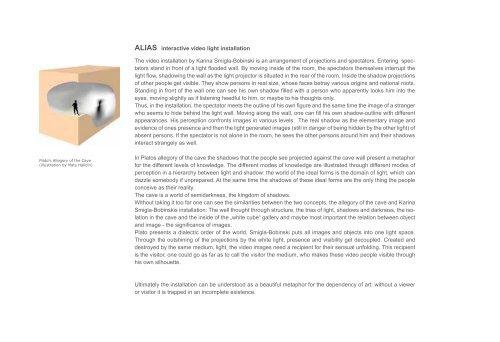Karina Smigla-Bobinski
Karina Smigla-Bobinski
Karina Smigla-Bobinski
You also want an ePaper? Increase the reach of your titles
YUMPU automatically turns print PDFs into web optimized ePapers that Google loves.
ALIAS interactive video light installation<br />
The video installation by <strong>Karina</strong> <strong>Smigla</strong>-<strong>Bobinski</strong> is an arrangement of projections and spectators. Entering spectators<br />
stand in front of a light flooded wall. By moving inside of the room, the spectators themselves interrupt the<br />
light flow, shadowing the wall as the light projector is situated in the rear of the room. Inside the shadow projections<br />
of other people get visible. They show persons in real size, whose faces betray various origins and national roots.<br />
Standing in front of the wall one can see his own shadow filled with a person who apparently looks him into the<br />
eyes, moving slightly as if listening heedful to him, or maybe to his thoughts only.<br />
Thus, in the installation, the spectator meets the outline of his own figure and the same time the image of a stranger<br />
who seems to hide behind the light wall. Moving along the wall, one can fill his own shadow-outline with different<br />
appearances. His perception confronts images in various levels. The real shadow as the elementary image and<br />
evidence of ones presence and then the light generated images (still in danger of being hidden by the other light) of<br />
absent persons. If the spectator is not alone in the room, he sees the other persons around him and their shadows<br />
interact strangely as well.<br />
Plato‘s Allegory of the Cave<br />
(illustration by Mats Halldin)<br />
In Platos allegory of the cave the shadows that the people see projected against the cave wall present a metaphor<br />
for the different levels of knowledge. The different modes of knowledge are illustrated through different modes of<br />
perception in a hierarchy between light and shadow: the world of the ideal forms is the domain of light, which can<br />
dazzle somebody if unprepared. At the same time the shadows of these ideal forms are the only thing the people<br />
conceive as their reality.<br />
The cave is a world of semidarkness, the kingdom of shadows.<br />
Without taking it too far one can see the similarities between the two concepts, the allegory of the cave and <strong>Karina</strong><br />
<strong>Smigla</strong>-<strong>Bobinski</strong>s installation: The well thought through structure, the trias of light, shadows and darkness, the isolation<br />
in the cave and the inside of the „white cube“ gallery and maybe most important the relation between object<br />
and image - the significance of images.<br />
Plato presents a dialectic order of the world, <strong>Smigla</strong>-<strong>Bobinski</strong> puts all images and objects into one light space.<br />
Through the outshining of the projections by the white light, presence and visibility get decoupled. Created and<br />
destroyed by the same medium, light, the video images need a recipient for their sensual unfolding. This recipient<br />
is the visitor, one could go as far as to call the visitor the medium, who makes these video people visible through<br />
his own silhouette.<br />
Ultimately the installation can be understood as a beautiful metaphor for the dependency of art: without a viewer<br />
or visitor it is trapped in an incomplete existence.


